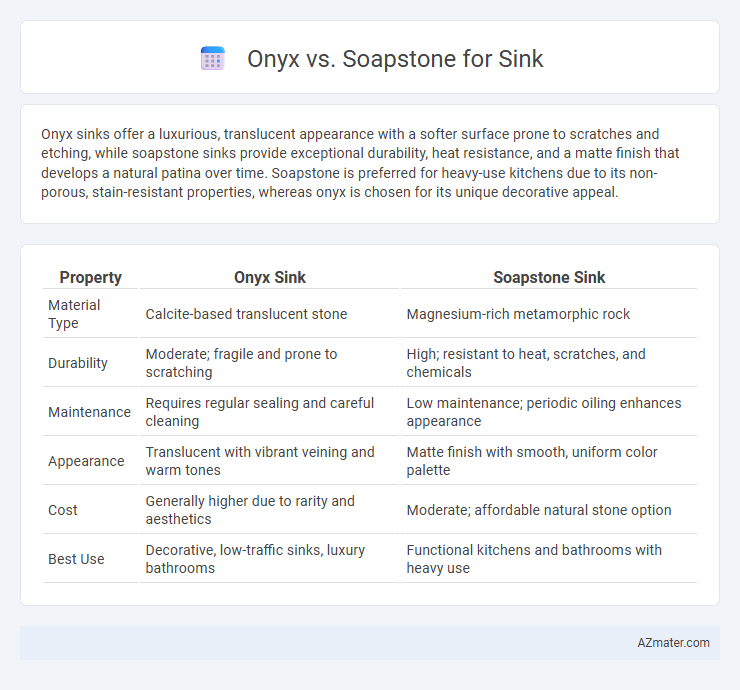Onyx sinks offer a luxurious, translucent appearance with a softer surface prone to scratches and etching, while soapstone sinks provide exceptional durability, heat resistance, and a matte finish that develops a natural patina over time. Soapstone is preferred for heavy-use kitchens due to its non-porous, stain-resistant properties, whereas onyx is chosen for its unique decorative appeal.
Table of Comparison
| Property | Onyx Sink | Soapstone Sink |
|---|---|---|
| Material Type | Calcite-based translucent stone | Magnesium-rich metamorphic rock |
| Durability | Moderate; fragile and prone to scratching | High; resistant to heat, scratches, and chemicals |
| Maintenance | Requires regular sealing and careful cleaning | Low maintenance; periodic oiling enhances appearance |
| Appearance | Translucent with vibrant veining and warm tones | Matte finish with smooth, uniform color palette |
| Cost | Generally higher due to rarity and aesthetics | Moderate; affordable natural stone option |
| Best Use | Decorative, low-traffic sinks, luxury bathrooms | Functional kitchens and bathrooms with heavy use |
Introduction to Onyx and Soapstone Sinks
Onyx sinks showcase a luxurious, translucent appearance with unique veining patterns, often crafted from natural calcite minerals that offer a striking aesthetic for upscale bathrooms. Soapstone sinks, made from dense metamorphic rock primarily composed of talc, provide exceptional durability and resistance to heat and stains, making them highly practical for daily use. Both materials present distinctive styles: onyx delivers elegance and decorative appeal, whereas soapstone emphasizes functionality and longevity.
Aesthetic Appeal: Onyx vs. Soapstone
Onyx offers a luxurious, translucent appearance with vibrant veins and rich color variations, creating a dramatic and elegant aesthetic for sinks. Soapstone provides a matte, earthy look with subtle veining and a smooth, natural texture that develops a unique patina over time, enhancing its rustic charm. Both materials deliver distinctive visual appeal, with onyx suited for statement pieces and soapstone ideal for understated, timeless designs.
Durability and Longevity Comparison
Onyx sinks, prized for their unique translucency and elegant patterns, are softer and more prone to scratching or etching compared to soapstone, which is renowned for its exceptional hardness and resistance to wear. Soapstone's dense, non-porous structure provides superior durability, making it highly resistant to stains, heat, and bacterial growth, which contributes to its long-lasting performance in kitchen and bathroom environments. While onyx requires more careful maintenance to preserve its aesthetic appeal, soapstone offers a robust, low-maintenance option that can endure heavy daily use without significant deterioration.
Maintenance Requirements: Onyx and Soapstone
Onyx sinks require gentle care with non-abrasive cleaners and prompt attention to stains due to their softer, porous nature, making them more prone to scratches and etching. Soapstone sinks offer superior durability and low maintenance, resisting stains and acids naturally, and only need occasional oiling to maintain their smooth, matte finish. Both materials benefit from careful handling, but soapstone is generally favored for ease of maintenance in busy kitchens.
Resistance to Stains and Scratches
Onyx sinks exhibit moderate resistance to stains but are more vulnerable to scratches due to their softer mineral composition, requiring careful maintenance to preserve their glossy surface. Soapstone sinks offer superior resistance to both stains and scratches, as their dense, non-porous structure naturally repels fluids and allows minor scratches to be easily buffed out. The durability and low maintenance of soapstone make it a preferred choice for kitchens or bathrooms prone to frequent use and staining.
Cost Differences: Onyx vs Soapstone Sinks
Onyx sinks generally cost more than soapstone sinks due to their rarity and unique translucence, with prices averaging between $600 and $1,200 per sink compared to $300 to $700 for soapstone options. Soapstone sinks offer durability and resistance to stains and heat at a lower price point, making them a cost-effective choice for kitchens and bathrooms. Maintenance costs also differ, as soapstone requires periodic oiling to maintain its appearance, while onyx demands professional sealing to prevent damage, influencing long-term expenses.
Installation Considerations
Onyx sinks require careful handling during installation due to their brittleness and susceptibility to chipping, making professional fitting essential to prevent damage. Soapstone sinks offer easier installation because their dense, non-porous nature allows for seamless mounting and resistance to staining or cracking. Both materials benefit from reinforced support structures, but soapstone's durability reduces the need for frequent maintenance after installation.
Environmental Impact and Sustainability
Onyx sinks, derived from natural calcite, have a higher environmental footprint due to intensive mining and limited recyclability, while soapstone sinks offer greater sustainability through abundant availability, minimal processing, and natural durability. Soapstone's resistance to heat, stains, and bacteria reduces the need for harsh cleaning chemicals, enhancing its eco-friendly profile compared to onyx. Choosing soapstone aligns with sustainable design by supporting long-lasting use and reducing overall environmental impact in residential or commercial kitchen settings.
Suitability for Kitchen and Bathroom Applications
Onyx offers a luxurious, translucent appearance ideal for statement kitchen sinks but requires careful sealing due to its softness and porosity. Soapstone provides exceptional durability and resistance to stains and heat, making it highly suitable for both kitchen and bathroom sinks where functionality is paramount. Both materials benefit from regular maintenance, but soapstone's natural oils enhance its patina over time, increasing its appeal in wet environments.
Conclusion: Choosing the Best Material for Your Sink
Onyx offers a luxurious, translucent appearance with a smooth, high-gloss finish, making it ideal for decorative sinks that prioritize aesthetics, though it requires careful maintenance due to its softness and susceptibility to scratches. Soapstone is a durable, non-porous material that resists stains, heat, and scratches, providing a practical and low-maintenance option suitable for busy kitchens or bathrooms. Selecting the best sink material depends on balancing the desire for visual elegance with functional durability and ease of care.

Infographic: Onyx vs Soapstone for Sink
 azmater.com
azmater.com